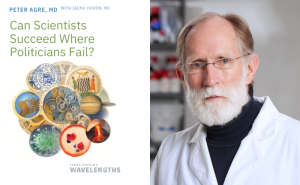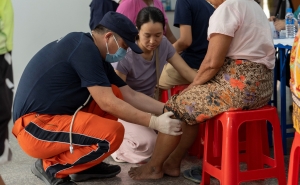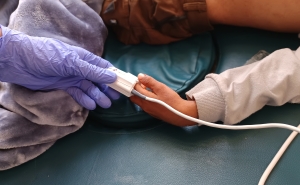A Doctor’s Perspective from Wuhan
Bin Cao, vice president and director of Respiratory and Critical Care Medicine at the China-Japan Friendship Hospital in Beijing, has worked on the front lines of patient care in Wuhan for the past few months. In closely monitoring the disease, he and his team are beginning to unlock some of its secrets. Cao talks to Josh Sharfstein about how the situation has changed in Wuhan, what we can learn about safeguarding providers, the primary risk factors for death, and the ongoing research that may reveal new treatment methods.
The following is a transcript of Cao's conversation with Sharfstein.
SHARFSTEIN: Welcome to Public Health on Call, a new podcast from the Johns Hopkins Bloomberg School of Public Health. Our focus is the novel coronavirus I'm Josh Sharfstein, a faculty member at Johns Hopkins, and also a former secretary of Maryland's health department. Our goal with this podcast is to bring evidence and experts to help you understand today's news about the novel coronavirus and what it means for tomorrow. If you have questions, you can email them to publichealthquestion@jhu.edu.
Today I'm speaking with Dr. Bin Cao, Vice President and Director of Respiratory and Critical Care Medicine at the China, Japan Friendship Hospital in Beijing. Dr. Cao has been working in Wuhan, China, responding to COVID-19 for the past two months. In this interview, he speaks about how the situation has changed in Wuhan over this last two months, about protecting health care workers from infection, about the risk factors for death from COVID-19 in Wuhan, and about ongoing research to identify treatments. Let's listen. Dr. Cao, thank you very much for joining me today from Wuhan, China. How are you doing today?
CAO: Fine.
SHARFSTEIN: Great. So let me just make sure I understand. You usually work in Beijing.
CAO: Yeah.
SHARFSTEIN: But for the last two months, you had been in Wuhan, both taking care of patients and doing research. Is that correct?
CAO: Yeah, correct.
SHARFSTEIN: And what is the situation now in Wuhan with respect to the novel coronavirus?
CAO: Yes. See, there is a very few new onset of COVID-19 cases, but one month ago, the situation was very different.
SHARFSTEIN: What was it like when you got there, to Wuhan?
CAO: You mean on that first day, right?
SHARFSTEIN: Yes.
CAO: Well, firstly, when we came to Wuhan, there were many, many cases. And Wuhan City opened new hospitals to entroll the many cases. And during the last month, yes, most of the patients recovered and discharged from the hospitals.
So that's good news. And then during the last one week, there are very few newly onset of the COVID-19 cases. Yes. And I'm happy to anticipate the normal life of the general population.
SHARFSTEIN: Well, that's very, very good news. While you have been there, I'm sure you have seen many things. Right now, we have cities in the United States that are thinking about what could happen in the United States. Based on your experience, do you have particular advice about how serious this problem can get?
CAO: Yes. Several days ago, the WHO general secretary, in a TV show, that, like I mentioned, that what's the priority that every country should pay enough attention as to the situation. I think it is the most important.
Another thing is very clear, that it is one kind of respiratory tract infection. And that disease can be transmitted from person to person.
SHARFSTEIN: And tell me about the challenges, or what has been done to protect health care workers in the hospital that you are working in Wuhan. What's been the most important to protect health care workers?
CAO: I think it is not the most difficult for health care workers, the prevention of the most common infection, and the doctors or nurses have the protective equipment such as the mask and the protective clothes, clothing. I think there is no worry about to be infected in hospitals.
SHARFSTEIN: And we've read that, initially, there were a lot of health care workers infected in Wuhan.
CAO: Yeah. So this is a lesson that the American doctors and American nurses should learn from China's side. Yes, in the beginning, yes. Because of that, in some hospitals, the doctors and nurses did not pay enough attention to the disease.
SHARFSTEIN: Before they knew what was really going on.
CAO: Yeah. I think it's a lesson, yeah. So I think the lesson that the Chinese doctors have given, yes, well, two months ago. So I do not want American doctors to have the same lesson. Now, if you realize that is a disease, is a transmittable disease, you will have find a way as to prevent most common infection. But if not, if you do not, do not think it's a new disease. You will suffer.
SHARFSTEIN: At risk. Yes, that's a risky situation. So, now I understand you've been leading some research projects in the hospital there. And you recently published a paper in The Lancet. Can you tell us the main finding of your paper?
CAO: Yes, yes. We have two papers published in The Lancet, you know, during the last month. The first paper was published in January 24, on the eve of a Chinese tradition, traditional holiday, the spring festival. So that second paper, we published two days ago. Yes. Yes, I have said that it's a new disease. So if we want to know the new disease, we have to spend time. It takes time for clinicians to learn the new disease. The two papers, two steps of the clinicians get to know the disease. The first step is that it's just like a portrait of a disease. So it's not very clear that we only figure out what that disease looks like, just as you look at yourself in the mirror in a long distance. So you cannot figure out how-- and I think that the most priority of the first paper is that we tell the world that is a disease caused by a new coronavirus. So this is a finding.
SHARFSTEIN: That was a very, very important paper. And what about the second paper?
CAO: The second paper that we go more detailed into the disease, which means that we closely monitor the progress of the disease from the onset of illness to the end. So the end means the discharge or death. So during the whole course, we have the close observation of the disease, such as how many days the fever will last, how many days the cough will last, and what percentage of patients still suffer from a cough on the day of discharge. And what are the change of the symptoms, such as if the patient recovered from fever but he had new onset of dyspnea or even shortness of breath. A part of them may even develop ARDS even after they have recovered from fever. So this is helpful.
SHARFSTEIN: So I see. That's lung failure. That's a very serious, serious problem. Even after they've recovered from fever, their lungs can fail.
CAO: Yeah, you are right.
SHARFSTEIN: Let me ask you this. There's been some questions that have come up about whether people who recover may be left with permanent lung disease of one kind or another. Is that covered in your paper? Do you have a view on that topic? Pulmonary fibrosis, for example, or other lung conditions, even if they recover?
CAO: Maybe next paper, but not in this paper. And another finding of this paper is that we find the risk factors for death. And in this paper we have three main findings. Firstly, the age. It is assumed that the elderly patients will die from the disease more easily compared with the young patients, and second, that we find the SOFA score. SOFA score is a marker for sepsis, and in this paper we mention that if previously you had sepsis, you really mean the bacterial infection, bacteremia. But in these situations they prove that the sepsis may be only due to virus—the coronavirus.
SHARFSTEIN: I see.
CAO: Yeah. It's a new concept.
Yes, we have the same situation of the patients has only new coronavirus infection, but no coinfection with bacteria. So this is another finding of this paper. Third is that we find that the increase D-dimer will be a good marker to predict the deaths of the patient.
SHARFSTEIN: I see. That's a blood test that can be done.
CAO: And a reader sent me an email asking the same question, that he's a faculty of a university, and his question is that, "Dr. Cao, can you explain that why D-dimer is a good predictor for deaths?"
Here is his answer. It will mean that the virus can bind to the cells of the human beings by the receptor of SA2, and there are a lot of SA2 receptors on the epithelium. This is at the top level of the cells. Another cell type is the endocytosis of the blood vessels.
SHARFSTEIN: I see.
CAO: So it seems that the virus can firstly invade the lungs, and from the lungs can spread to the blood. And as soon as the virus spreads into the blood vessel, the virus will bind to the endocyte.
SHARFSTEIN: I see. That's one of the cells in the blood vessels, and then it can even replicate there.
CAO: Damage—damage the endocyte. As soon as there is a damage or endocytosis, there will be clots, and the clots will be everywhere.
SHARFSTEIN: And that can really put somebody at risk for death right there, when that happens.
Let me ask you about treatment. What has been the most successful treatment, and what kind of research studies are underway right now to find even more successful treatments?
CAO: Yeah, I think there's, I suppose, an easy question and a difficult question. The easy question is, is it an infectious disease? Is it an infectious disease caused by a virus? So the easy answer is that we should use antivirals. So it's an easy question.
A difficult question is that, how can we find an effective and a safe anti-virus? So at this time, yes, our team is leading three clinical trials of antivirals to COVID-19. The first trial is the Kaletra trial. Lopinavir and ritonavir. And this trial we have successfully completed, and our paper is under review. So I think the audience will read our paper maybe next week or in two weeks.
After that, we have been leading two remdesivir trials. Remdesivir 1, remdesivir 2 focuses on large to moderate pneumonia cases, and remdesivir 2 for the severe and critical cases. Both remdesivir trials are moving forward. I think maybe the remdesivir 2 for severe and critical cases is faster compared with mild to moderate cases. So maybe I think the audience will read out paper next month.
SHARFSTEIN: And there's another trial, a third trial too?
CAO: Yeah. There's one lopinavir trial, two remdesivir trials.
SHARFSTEIN: I see. Oh, got it. OK.
CAO: So I think it is the Chinese physician's contribution to international society.
SHARFSTEIN: It's going to be extremely important. Their studies will be extremely important.
CAO: Yeah. There's another trial we are conducting now, yes. You mentioned the convalescent plasma trial, and we have also registered in our local registration website. At this time, yes, we have tested no more than 100 patients, so I cannot tell you what the effects-- but it seems that the list of that convalescent plasma is safe in our clinical trials.
So I think maybe it is an option for treatment, but—
SHARFSTEIN: But we'll have to see the data and whether people get better. We'll have to see the study.
CAO: Yeah. But the trial only testing severe or critical cases, so we have no data for mild to moderate cases.
SHARFSTEIN: I see—for plasma at this point.
CAO: Yeah.
SHARFSTEIN: Well this is extremely helpful, important information. I want to thank you for spending time with us and for all that you are doing for the people of Wuhan over the last two months, starting when it was obviously very difficult, and now when the number of cases has dropped considerably. And thank you for the information and the lessons for the United States and other countries around the world. And I really wish you the best in all the work that you're doing to identify a treatment for patients with COVID-19.
CAO: Thank you.
SHARFSTEIN: Thank you for listening to Public Health On Call, a new podcast from the Johns Hopkins Bloomberg School of Public Health. Please send questions to be covered in future podcasts to publichealthquestion@jhu.edu.
This podcast is produced by Josh Sharfstein, Lindsay Smith Rogers, and Lymari Morales. Audio production by Niall Owen McCusker and Spencer Greer with support from Chip Hickey. Distribution by Nick Moran. Thank you for listening.
Articles referenced in this podcast:
- Clinical features of patients infected with 2019 novel coronavirus in Wuhan, China—The Lancet
- Clinical course and risk factors for mortality of adult inpatients with COVID-19 in Wuhan, China: a retrospective cohort study—The Lancet
Subscribe for updates on our content and events, including the latest expert insights on COVID‑19.
RELATED CONTENT
Public Health On Call
This transcript comes from the March 27 episode of the Public Health On Call podcast.





